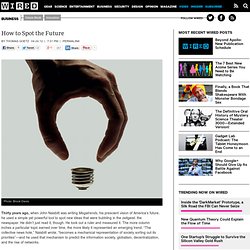

Prototype engine will allow travel from London to Sydney in four hours. NASA Starts Work on Real Life Star Trek Warp Drive. Productivity Future Vision (2011) 3D printed exoskeleton gives two-year-old ability to move her arms.
Arthur C. Clarke Predicts the Future in 1964 … And Kind of Nails It. Is this the future of Project Glass? – Cell Phones & Mobile Device Technology News & Updates. Wearable technology, and computing equipment that acts more like another limb then a gadget, has gotten a lot of attention recently thanks to Google . Project Glass made a big splash not too long ago at Google’s annual developer conference when they showed several users falling on to the Moscone West in San Francisco. Google’s pretty bent on showing us the sharing possibilities with Project Glass, but it feels like in time that technology could become a ubiquitous part of our lives.
Fortunately for those of us who lack a hyperactive imagination, a short film popped up recently that can help fill in the blanks. I love the world that was created in this film, and how it was all made possible by wearable tech. Instead of a television, there’s just an empty wall that the contact lenses fill in with whatever you want to watch. I reached the end of the short film and, despite the frightening turn the technology took, would gladly sign up to have that tech.
MIT Creates Amazing UI From Levitating Orbs. Anyone else see The Avengers?

Just like in Iron Man 1 and 2, Tony Stark has the coolest interactive 3-D displays. He can pull a digital wire frame out of a set of blueprints or wrap an exoskeleton around his arm. Those moments aren’t just sci-fi fun; they’re full of visionary ideas to explore and manipulate objects in 3-D space. Except for one thing: How would Stark feel all of these objects to move them around? In reality, he’d be touching nothing but air. Jinha Lee, from the Tangible Media Group of the MIT Media Lab, in collaboration with Rehmi Post and Hiroshi Ishii, has been playing with the idea of manipulating real floating objects in 3-D space to create a truly tactile user interface. It’s essentially a small field in which gravity doesn’t overcome an object. “There is something fundamental behind motivations to liberate physical matter from gravity and enable control.
Interviewing Lee, I realized he’s one-part scientist, one-part philosopher. [Hat tip: designboom] James Bond theme on Eigenharp. Sensordrone Kickstarter pitch. Robotic Quintet Composes And Plays Its Own Music. Sound Machines 2.0 is Festo's latest effort to create robotic musicians.

The German engineering firm Festo has developed a self-playing robotic string quintet that will listen to a piece of music and generate new musical compositions in various musical styles effortlessly. Dubbed Sound Machines 2.0, the acoustic ensemble is made up of two violins, a viola, a cello, and a double bass, each consisting of a single string that is modulated by an electric actuator for pitch, a pneumatic cylinder that acts as a hammer to vibrate the string, and a 40 watt speaker. A new composition is generated in a two-stage process. First, a melody played on a keyboard or xylophone is broken down into the pitch, duration, and intensity of each note, and software with various algorithms and compositional rules derived from Conway’s “Game of Life” generates a new composition of a set length. Here’s an example of what the robots can produce: It’s worth taking a look at the Sound Machines 1.0 too:
Robotic grippers based on granular jamming. Io9. We come from the future. How to Spot the Future. Photo: Brock Davis Thirty years ago, when John Naisbitt was writing Megatrends, his prescient vision of America’s future, he used a simple yet powerful tool to spot new ideas that were bubbling in the zeitgeist: the newspaper.

He didn’t just read it, though. He took out a ruler and measured it. The more column inches a particular topic earned over time, the more likely it represented an emerging trend. “The collective news hole,” Naisbitt wrote, “becomes a mechanical representation of society sorting out its priorities”—and he used that mechanism to predict the information society, globalism, decentralization, and the rise of networks. As clever as Naisbitt’s method was, it would never work today. This may sound like a paradox. So how do we spot the future—and how might you? It’s no secret that the best ideas—the ones with the most impact and longevity—are transferable; an innovation in one industry can be exported to transform another.